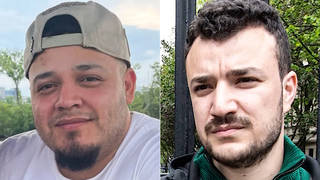
Guests
- Spencer Woodmanstaff reporter for the International Consortium of Investigative Journalists.
Links
Since 2012, ICE has used solitary confinement as a routine punishment for thousands of immigrants and asylum seekers locked up in immigration jails across the country. We look at a new, damning investigation by the International Consortium of Investigative Journalists that has revealed this widespread abusive use of solitary confinement in immigration jails overseen by U.S. Immigration and Customs Enforcement. The United Nations special rapporteur on torture says solitary confinement should only be used in exceptional circumstances, and defines extended use of solitary as “inhuman and degrading treatment.” Despite this, a review of more than 8,400 reports of solitary confinement in ICE detention found that immigration officers repeatedly used isolation cells to punish gay, transgender and disabled immigrants for their identities and to target other jailed immigrants for actions like kissing consensually or hunger striking. Almost a third of the people held in solitary confinement suffered from mental illness. In at least 373 cases, immigrants were put in isolation for being potentially suicidal. In nearly 200 instances, immigrants were held in solitary confinement for more than six months. The investigation is called “Solitary Voices.” We speak to one of its lead authors, Spencer Woodman.
Transcript
AMY GOODMAN: This is Democracy Now! I’m Amy Goodman, with Juan González.
JUAN GONZÁLEZ: We turn now to a damning investigation revealing the widespread abusive use of solitary confinement in immigration jails overseen by U.S. Immigration and Customs Enforcement. The United Nations special rapporteur on torture says solitary confinement should only be used in exceptional circumstances, and defines extended use of solitary as “inhuman and degrading treatment.” Despite this, a new, devastating report by the International Consortium of Investigative Journalists reveals that since 2012 ICE has used solitary confinement as a routine punishment for thousands of immigrants and asylum seekers locked up in immigration jails across the country.
AMY GOODMAN: The review of more than 8,400 reports of solitary confinement in ICE detention found immigration officers repeatedly used isolation cells to punish gay, transgender and disabled immigrants for their identities and to target other jailed immigrants for actions like kissing consensually or hunger striking. Almost a third of the people held in solitary confinement suffered from mental illness. In at least 373 cases, immigrants were put in isolation for being potentially suicidal. In nearly 200 instances, immigrants were held in solitary confinement for more than half a year.
The investigation is called “Solitary Voices.” This is an excerpt of a video released along with the report.
UNIDENTIFIED: You’re being locked up for 23 hours, 22 hours in a day, in a small room.
ILYAS MURADI: It’s like a cage, you know?
UNIDENTIFIED: It made me feel like going crazy.
UNIDENTIFIED: You can’t even talk to nobody.
UNIDENTIFIED: I contemplated, you know, trying to hurt myself, kill myself, because I just couldn’t bear being alone.
UNIDENTIFIED: It’s hard. It’s really hard.
ELLEN GALLAGHER: It’s presented as though it’s a form of protection, when in fact the experience of the individual is “This is extreme punishment.” If the only way you can assure the safety of civil detainees, who are extremely vulnerable based on their background or their mental or physical health, is to put them into a 24-hour or 22-hour lockdown, I think it raises a profound question about the overall system.
JUAN GONZÁLEZ: That was Ellen Gallagher, Department of Homeland Security policy adviser and a whistleblower, who repeatedly warned immigration officials that ICE was in violation of its own standards. “Solitary Voices” is an investigation by the International Consortium of Investigative Journalists in collaboration with a number of other news outlets.
AMY GOODMAN: Congressmember Ilhan Omar shared the investigation on Twitter Tuesday, writing, “Solitary confinement is torture. It’s time we abolish ICE,” she wrote.
Well, for more, we’re joined here in New York by Spencer Woodman, staff reporter for the International Consortium of Investigative Journalists and the lead reporter for the new investigative series “Solitary Voices.”
Welcome to Democracy Now! Great to have you with us. So, lay out what you found and how you went about doing this report.
SPENCER WOODMAN: Sure. So, we found that ICE has repeatedly overused and misused solitary confinement to manage its sprawling detention network. The report is based on 8,500 incident reports describing—that we obtained through the Freedom of Information Act request—describing individual placements of detainees in solitary confinement. We also interviewed dozens of these detainees, who have spent time, sometimes very prolonged periods of time, up to a year, in solitary confinement cells at ICE facilities.
And along the way, we got wind of a whistleblower, who has a supervisory role within the Department of Homeland Security, who has for years been trying to effect change internally through formal whistleblowing channels at DHS with little luck. And yesterday she came out publicly for the first time to tell her story.
JUAN GONZÁLEZ: Now, most Americans are not aware that people being held by ICE in these detention facilities, these are basically—they’re under civil penalties. They’re not under—they’re not being detained for crimes necessarily, right? Can you talk about the distinction and the importance of that in terms of solitary?
SPENCER WOODMAN: That’s right. Under U.S. law—and the Supreme Court has repeatedly affirmed this—civil detention cannot be used as a—for any form of punishment. It’s not punitive in nature. And what we’re seeing in immigrant detention in the United States are highly punishing forms of solitary confinement being used on detainees routinely and, in many cases, as a first resort to manage these facilities.
It might be worth it to just kind of step back for a second and talk about what a solitary confinement cell is, because before I started doing this reporting, I didn’t totally know what a solitary confinement cell is. I mean, it’s not the sort of jail cell you think of, with bars on one side and stuff like that. The important thing to remember is that a solitary confinement cell, actually, it’s a bathroom-sized room that you’re locked in, of course, but it has a solid metal door with—typically, with a small window encased with safety glass. And when they close and lock that solid metal door, you are in a armored, sealed box. And you can’t get out. And you can’t—there is no opportunity to speak with anyone. If you want to have a conversation, get something off your chest, get some fresh air, you can’t get out of that little room. And if you yell out, you can be additionally sanctioned to more time in solitary.
AMY GOODMAN: We’re showing a door that says “suicide safe.” But the fact of the matter is, I mean, it has been shown over and over again that people held for long periods of time in solitary become more suicidal.
SPENCER WOODMAN: Right. So, I mean, suicidality is one of the long—is, you know, among the long list of very serious harms, that are well known and well documented, that result from being in solitary confinement. One of the things that was quite striking that we came across were hundreds of reports of detainees becoming suicidal in solitary confinement, and then, because of their suicidal impulses or even suicide attempts in solitary confinement, being moved to another solitary confinement cell designed to manage suicidal detainees, which are at—some of these cells are actually more harsh than the cells that drove these detainees to attempt suicide in the first place.
JUAN GONZÁLEZ: Tell us a little bit about how you got onto this story, because you had initially filed a Freedom of Information request and had gone for a couple of years without any response. And why was it necessary to have an international group of journalists throughout Latin America participate in the uncovering of a story that was basically here in the United States?
SPENCER WOODMAN: Sure. So, yeah, in early 2017, I filed a Freedom of Information Act request with ICE, asking for agency-wide logs of their placements of detainees in solitary confinement. I had filed a few similar requests of narrower scope around that same time. And I actually—after a few months, I had forgotten I filed this larger request. And about two years later, I opened my mailbox to find a letter from ICE with a CD containing a huge trove of thousands and thousands of these incident reports. So that is what basically started the investigation. And ICIJ, where I work, we typically partner with international news organizations to do stories that cross borders.
AMY GOODMAN: You did the Panama Papers.
SPENCER WOODMAN: We did the Panama Papers. And so, this was a pretty good opportunity to both get the story out to a Spanish-language audience and to also work with reporters who work in populations who have been affected by solitary confinement at ICE. So, yeah.
AMY GOODMAN: I want to go to a clip from an NBC interview with two trans women who were held in isolation while in ICE custody. In this clip, you’ll hear from Dulce Rivera, a trans woman from Honduras who was kept in solitary confinement for 11 months while in ICE custody and attempted suicide. But first, this is Joselin Mendez, a trans woman from Nicaragua who was put in solitary confinement twice for a total of nine days.
JOSELIN MENDEZ: [translated] And, well, the truth is, what I went through in there is something I don’t even wish on my worst enemy. It’s horrible. I felt like I really didn’t know what was going to happen to me. I felt afraid. I felt that I couldn’t even breathe. And at the beginning, I began to scream and scream where they locked me up. I told them, “Release me. I can’t stand it. I am short of breath.”
DULCE RIVERA: [translated] I asked them for help. I told them, “I need to see a psychologist. I need to see a psychologist.” And what happened is that the guard’s response was “no.” So then I decided to tie a piece of blanket to the window above, and I completely covered the door outside so that no one was seeing what was happening inside the room. I made a lasso. I hung myself. So it’s something psychological, mental, that it affected me being in that place. So disgusting and horrible.
AMY GOODMAN: So, that was Dulce Rivera in an NBC report. She is from Honduras, originally held in an El Paso processing center. Now I want to turn to a video from the series “Solitary Voices.” This is Ilyas Muradi, a 30-year-old from Afghanistan who came to the U.S. when he was 12. Muradi has spent most of the last four months in solitary at ICE’s South Texas Detention Complex.
ILYAS MURADI: My first name is I-L-Y-A-S. Ilyas Muradi. I’m in solitary at the moment myself. It’s like a cage, you know? The door has a little tiny window in it. There is nothing to see. It seems like I woke up in a nightmare.
I was born in Afghanistan. My father got killed with a bomb in Afghanistan. We get accepted as refugees to come to the United States. I was 12, going 13.
NARRATION: Muradi became a truck driver and had two children. He says his permanent resident card was extended in 2017. But months later, U.S. immigration officials stopped him on the way back from Mexico.
ILYAS MURADI: They pulled me out of the car. They said that all my papers were wrong, that I shouldn’t have left the country. They arrested me. I’ve been sitting since 2017 here. And I appealed my case, and the board of appeal rejected.
NARRATION: Now Muradi expects to be deported back to Afghanistan.
ILYAS MURADI: I have no idea about the country. Every time when I think about it, about going there, I get scared, you know? I don’t know what’s going to happen.
NARRATION: Immigration and Customs Enforcement said Muradi has been put in solitary confinement seven times for disorderly conduct. When ICIJ reporters talked to him, in March and April, he had been in solitary for more than a month.
ILYAS MURADI: You think you’ll go crazy. I force myself trying to go to sleep or trying to read. You don’t have any more hopes.
NARRATION: On April 17, Muradi was briefly released from isolation. On April 26, he was locked up again “for threatening a staff member” and other misconduct, ICE said.
ILYAS MURADI: Sometimes you just sit down and be sad, and you cry. You are 20 to 22 hours a day in the cell by yourself. You get to go outside in that, like, little box. All you can see is the sky. Everything else is four walls. And all I see is: When’s going to be the day I can be free, so I don’t have to see these walls in front of me, so I can just see freedom?
AMY GOODMAN: That’s Ilyas Muradi, 30-year-old from Afghanistan, has been in this country since he was 12 years old, spent most of the last four months in solitary in ICE’s South Texas Detention Complex. And, Spencer, we’re listening to him on the telephone. Explain how you even recorded this.
SPENCER WOODMAN: So, Ilyas called me. And, you know, detainees who are put in solitary confinement, their privileges can be severely curtailed. They can, at some point, get access to phone privileges. So, that basically means a detention officer hands a phone through the meal slot in that solid metal door and allows them to talk on the phone, usually kind of huddled up to the door, because the phone cord isn’t very long. So that was him—that was Ilyas Muradi in his solitary confinement cell talking to me.
You know, it’s worth noting that people who are already in psychological distress are much more prone to the worst harms of solitary confinement. And a lot of people in immigration detention are under a lot of stresses. I mean, they’ve been, in many cases, separated from their families. In a lot of cases, they’re pending removal back to countries where they might not be safe.
So, this was the case of Ilyas Muradi. And, you know, the psychological decompensation that happens in solitary confinement was pretty obvious talking to him. There were certain points where he broke down and he wasn’t really able to have a conversation. And that kind of—that difficulty socializing and just that basic emotional distress, we found over and over again when we talked to particularly people in solitary confinement, the difficulty to even have a conversation.
AMY GOODMAN: Well, we’re going to have to leave it there.
SPENCER WOODMAN: Yeah.
AMY GOODMAN: But we will link to your piece, Spencer Woodman, a staff reporter for the International Consortium of Investigative Journalists, lead reporter on this new investigative series, “Solitary Voices,” on the widespread misuse of solitary confinement in ICE detention centers.
When we come back, we’ll look at how a predatory lending scheme has put many New York taxi drivers into debilitating debt, creating a system that’s been likened to “modern-day indentured servitude.” Back in 30 seconds.












Media Options